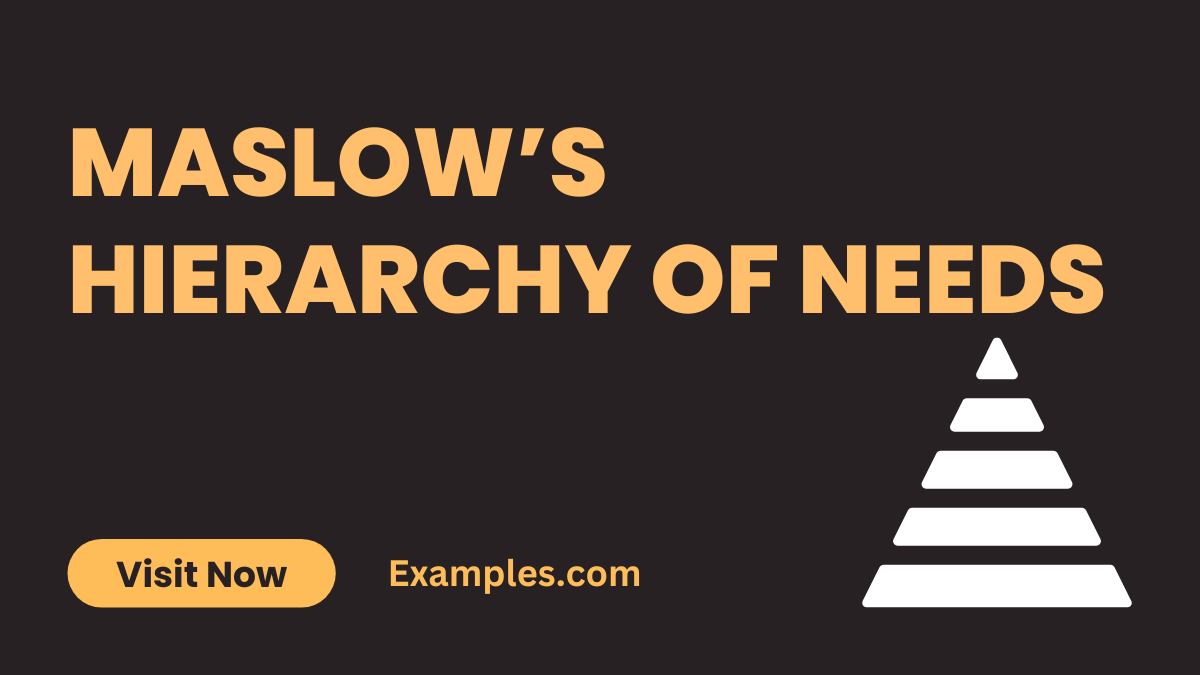Maslow’s Hierarchy of Needs Examples
Maslow’s Hierarchy of Needs is a seminal concept in psychology, particularly relevant in Intrapersonal Communication. Developed by Abraham Maslow, this theory suggests that human needs are arranged in a hierarchy, starting from basic physiological needs to the need for self-actualization. Understanding this hierarchy is crucial in comprehending human motivation and behavior, and it plays a significant role in personal development and effective communication with oneself and others.
What is Maslow’s Hierarchy of Needs?

Maslow’s Hierarchy of Needs is a psychological theory that categorizes human needs into five levels in a pyramid structure. The levels are: physiological needs (food, water), safety needs (security, stability), social needs (belonging, love), esteem needs (respect, recognition), and self-actualization (achieving one’s full potential). Each level needs to be fulfilled before moving to the next, influencing motivations and behaviors significantly.
History
Who Created: Abraham Maslow
Date: 1943
Maslow’s Hierarchy of Needs is a theory in psychology that has had a profound impact on various fields, including education, business, and Intrapersonal Communication.
What is the Best Example of Maslow’s Hierarchy of Needs?

A classic example of Maslow’s Hierarchy of Needs in action is a career progression. Initially, an individual may seek a job to fulfill physiological needs (salary for food, shelter). As they secure these, the focus shifts to safety needs (job security), then to social needs (workplace relationships), followed by esteem needs (recognition, promotions), and ultimately striving for self-actualization (fulfilling personal career aspirations and potential).
Examples of Maslow’s Hierarchy of Needs

Maslow’s Hierarchy of Needs is a vital concept in understanding human motivation and behavior, playing a significant role in areas like Intrapersonal Communication and personal development. This psychological theory outlines a five-level hierarchy of needs, from basic physiological needs to the pursuit of self-actualization. Here are 10 examples that illustrate these needs in real-life scenarios:
- Physiological Needs – Hunger and Thirst: Basic survival needs such as food and water are fundamental. “Feeling hungry, I need to have a meal to keep my energy up for my tasks.”
- Safety Needs – Job Security: The need for a stable and secure environment is crucial. “Having a steady job ensures that I can pay my bills and live without constant worry.”
- Social Needs – Family Relationships: Humans have an inherent desire to belong and be loved, often fulfilled through family and friends. “Family gatherings are important to me as they make me feel part of something bigger.”
- Esteem Needs – Recognition and Respect: Esteem needs involve the desire for respect, status, and recognition from others. “Receiving praise at work for a job well done boosts my confidence and sense of accomplishment.”
- Self-Actualization – Personal Growth: This highest level is about realizing personal potential and seeking personal growth. “Learning new skills in my hobby is fulfilling as it helps me grow and develop.”
Functions of Maslow’s Hierarchy of Needs
Maslow’s Hierarchy of Needs serves several important functions in understanding human behavior and Intrapersonal Communication:
- Explains Motivation: It provides a framework for understanding what drives human behavior at different stages.
- Guides Personal Development: Helps individuals identify their current level of needs and what they require for further growth.
- Enhances Self-Awareness: Assists in recognizing personal needs and motivations.
- Facilitates Empathy: Understanding different levels of needs helps in empathizing with others’ experiences and motivations.
- Improves Communication: By understanding one’s own and others’ needs, communication can be more effectively tailored.
- Aids in Conflict Resolution: Recognizing unmet needs can explain conflicts and guide resolution strategies.
- Supports Mental Health: Addressing each level of needs is crucial for overall mental well-being.
- Informs Workplace Dynamics: In organizational settings, it assists in understanding employee motivations and improving workplace relationships.
The functions of Maslow’s Hierarchy are instrumental in both personal and professional contexts, enhancing Intrapersonal Communication and interpersonal interactions.
Levels of Maslow’s Hierarchy of Needs
Maslow’s Hierarchy of Needs is structured into distinct levels, each representing different types of human needs:
- Physiological Needs: The base level, including essential elements for survival such as food, water, and shelter.
- Safety Needs: The second level, focusing on security, stability, and freedom from fear.
- Social Needs: The third tier, where social interactions, love, and belonging are prioritized.
- Esteem Needs: The fourth level, where respect, self-esteem, and recognition are sought after.
- Self-Actualization Needs: The pinnacle of the hierarchy, involving the pursuit of personal potential, self-fulfillment, and personal growth.
- Progression through Levels: Generally, individuals must satisfy lower-level needs before progressing to higher levels.
- Fluctuation Between Levels: It’s possible for individuals to move between levels based on life circumstances.
- Cultural and Individual Differences: The importance and interpretation of these levels can vary greatly among different cultures and individuals.
Understanding these levels is crucial in the field of Intrapersonal Communication, as they provide insight into personal motivations and behavioral patterns.
Maslow’s Hierarchy of Needs offers a profound understanding of human motivation and behavior, essential in the realm of Intrapersonal Communication. This guide has delved into the various levels of needs, from basic physiological requirements to the pursuit of self-actualization. Recognizing and addressing these needs is key to personal development, enhancing communication with oneself, and navigating life’s challenges with a deeper sense of purpose and fulfillment.



